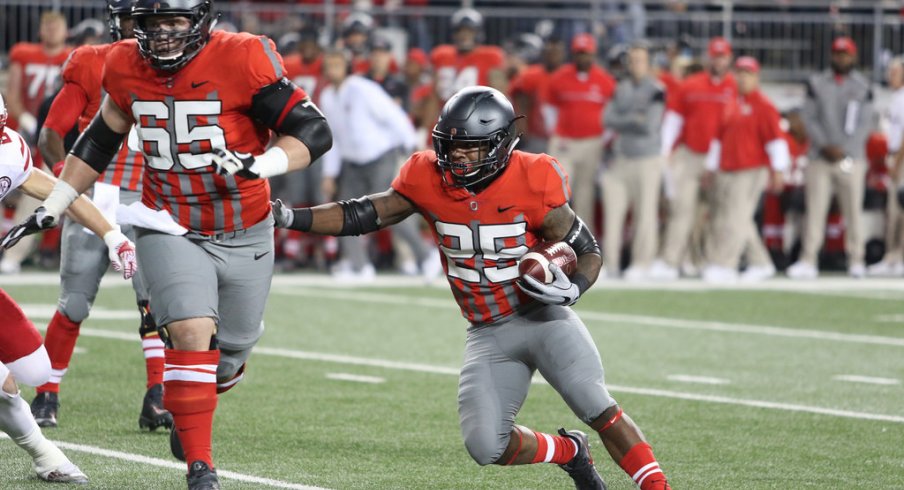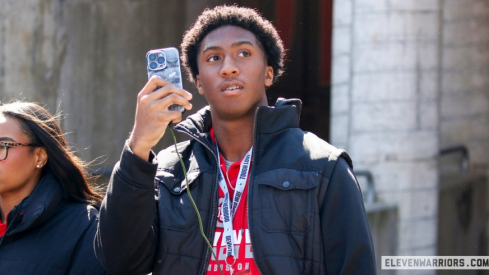Zone blocking occupies a unique place in football's schematic history.
Though its origins date back a half-century, it wasn't until John Elway, Terrell Davis, and the Denver Broncos won back-to-back Super Bowls in the 1990s that this 'new' style of run blocking became popular. After they saw two championships and a new runner racking up thousands of yards every year in the second half of the decade, coaches quickly flocked to the Mile High city, hoping to understand how they could implement the scheme themselves.
The beauty in offensive line coach Alex Gibbs' system was its simplicity. Instead of trying to teach a delicate ballet that delivered the runner through a gap determined well before the ball was snapped, Gibbs instead drilled his players on a series of rules that could be implemented to create a gap anywhere across the line.
To boil the thinking down to its simplest form, if a blocker has a defender in front of him, that's who he blocks. If there's no defender, the blocker helps the guy next to him, creating a double-team. Gibbs taught the scheme only two ways - Tight and Wide (inside and outside), with the only difference being the footwork of his linemen and the runner's aiming point.
This simplicity was a godsend to the burgeoning movement of spread offenses that would take flight just a few years later. These teams wanted simple, yet effective schemes that could be run over and over in their uptempo systems, allowing the offense to have to master only a handful of concepts while keeping the defense constantly on its heels.
Like their contemporaries, both Urban Meyer and Randy Walker became attentive students of Gibbs' work, implementing zone blocking as a foundational element in their playbooks at Bowling Green and Northwestern. Once word got out about a funny little wrinkle that added a bootleg option for the quarterback to keep and run the opposite way, the rest was history.
Walker's offensive line coach and play-caller was, of course, Meyer's current coordinator in Columbus, Kevin Wilson. While the two have never coached together before, the marriage of their two styles should be an easy one for the Ohio State offense, as both still rely heavily on zone blocks.
While Wilson built a reputation for churning out star running backs like Adrian Peterson and DeMarco Murray at Oklahoma, and later Tevin Coleman and Jordan Howard at Indiana, Meyer famously didn't produce a single 1,000-yard rusher during his stints at B.G., Utah, or Florida. It wasn't until 2012 when Braxton Miller began a streak of five consecutive seasons with at least one Buckeye breaking the 1K mark in a season.
However, the way in which Meyer's offenses have relied on zone schemes has varied greatly compared to that of Wilson. Over the past few seasons, the Buckeyes have only called for the Wide zone play when looking to break a big play around the edge, giving the runner a host of extra blockers and changing his aiming point to the D-gap outside the tight end.
Instead, Meyer's Ohio State offenses have relied heavily on the Tight zone, leading to a host of new looks coming their way over the years. Though the most notable counter was Virginia Tech's 'Bear' front, defenses have tried everything to slow down this single concept, knowing how fundamental it had become to the Buckeyes' success.
Wilson, on the other hand, seemed far more willing to rely on the classic version of Gibbs' Outside zone concept, teaching his backs to read the defense and hit the '3 Bs.'
The first B is BANG, as in, bang the gap that was designed. After taking the handoff, the back takes three steps laterally at which time, if the blocking allows, he plants his outside foot in the ground and cuts upfield, hitting the designed gap perfectly.
Just as it was taught twenty years ago, Wilson's Indiana offense was running the play almost identically this past fall, hitting the talented Buckeye defense for big gains during their October visit to the Horseshoe. From Gibbs' words:
"On the third step, the running back is either going downhill or taking the ball outside. The reason the decision is made on the third step is the timing of the blocks within the offensive line. On the third step, the offensive lineman make their push on the defenders. The push of the offensive line and the cut of the back must coincide."
However, as we all know, sometimes defenses will overplay a specific gap, looking to stuff the run once they read the first steps of the offensive linemen. In this system, the back is taught to read the defenders outside-in, meaning he'll see if the edge defender has pinned himself too far inside. When this happens, the runner follows the second B, BOUNCE.
What stands out the most when watching film of Wilson's offenses in Bloomington, though, is the way in which his teams rely on the third B, BEND, better known as a cutback. Though they'd often run the Tight zone as well, Wilson's Hoosiers often used the Outside version to pick up yards between the tackles.
Though many would assume the best way to run the ball straight ahead is to push the defense backward. But the Hoosiers were at their best when the defense was moving sideways, finding a crease and exploiting it with a disciplined and decisive runner.
To help ensure the cutbacks were successful, Wilson would add in little wrinkles, like lining up an extra offensive lineman on the backside of the play to seal off the end (above), or give a false read to the defense by pitching the ball to the back, a seemingly sure sign that he's headed outside (below).
Additionally, Wilson adapted a classic Tight zone variation wrinkle to fit his Outside philosophy, by adding in a kick-out block in the 'split' zone scheme. Here, the back's aiming point is always a cutback, and although the line steps laterally as though they're looking to create a gap on the right, they're actually trying to build a wall along the left by sealing in their defenders.
Ironically, Wilson's success fitting the zone scheme into his spread template helped bring spread philosophies mainstream. While most pundits will talk about how Tom Brady and the Patriots operate primarily from the shotgun these days, running mostly four and five-wide receiver sets, the Atlanta Falcons reached Sunday's Super Bowl by relying heavily on zone-blocking.
It's no surprise that Falcons play-caller Kyle Shanahan is a believer in the system that brought his dad two Super Bowl rings, but he's doing it by handing off to Wilson's star pupil, bringing things full circle.
But Buckeye fans should care about this potential addition to future game plans as well. Previously, Meyer relied on a duo of backs to deliver his inside-outside punch, such as Hyde and Miller in his first two seasons in Columbus, and Mike Weber and Curtis Samuel this past fall. With Samuel off to the NFL, this new scheme is perfect for a back like Weber, who has already shown the patience needed to succeed in a zone blocking scheme.
More importantly, though, the use of outside zone blocking to create inside running lanes allows Meyer to establish the power running game he craves by yet another means. While the addition of Wilson to the Buckeye staff may not signal a philosophical change, hopefully, it triggers this tactical one.



